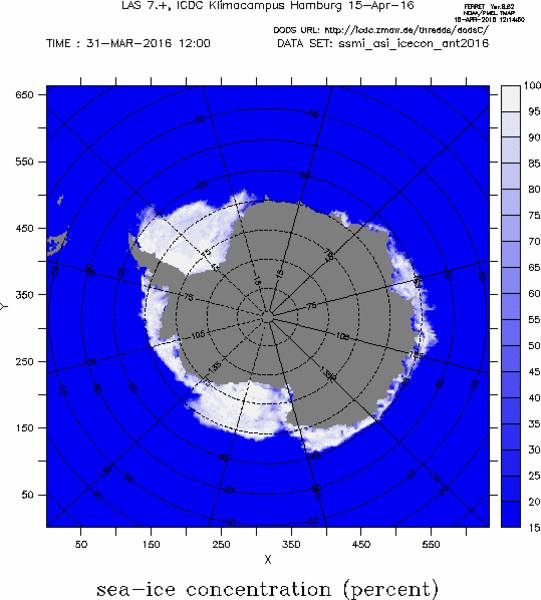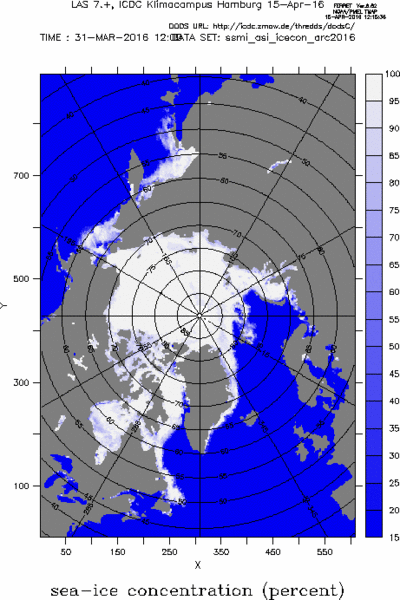Polar sea-ice concentration from ASI-SSMI


Topics
- Access
- Description
- Parameters
- Coverage, spatial and temporal resolution
- Data quality
- Contact person
- References
- Data citation
Access
UNRESTRICTED:
- Get ASI-SSMIS sea-ice concentration data via FTP
- Access ASI-SSMIS sea-ice concentration data via OPeNDAP
RESTRICTED:This link to the data set is only available for a restricted user group. The data set is only accessible in CEN/MPI net or accessible from external nets with a customer account. Please contact ICDC if you would like to access this data from outside the network.
- Data access via file system: /data/icdc/ice_and_snow/asi_ssmi_iceconc
Description
Special Sensor Microwave / Imager (SSM/I) and Special Sensor Microwave / Imager Sounder (SSM/IS) have been used to produce a finer resolved sea-ice concentration data set gridded onto a polar-stereographic grid true at 70 degrees with 12.5 km grid resolution. The sea ice concentration data available here have been computed at IFREMER by applying the ARTIST Sea Ice (ASI) algorithm to brightness temperatures measured with the 85 GHz SSM/I and/or SSM/IS channels. These channels have a considerably finer spatial resolution than the commonly used lower frequency channels.
The ASI algorithm is described in Kaleschke et al. (2001) and Spreen et al. (2008) (see references).
ICDC applies a 5-day median filter to reduce the weather influence (see e.g. Kern et al. (2010) at references).
So far there are no estimates of the uncertainties included in the data product. This is planned for version 02 of this data product.
This data set is an ICDC / CliSAP - IFREMER product.
Last update of data set at ICDC: April 30, 2025.
Parameters
| Name | Unit |
|---|---|
| Sea ice concentration | % |
Coverage, spatial and temporal resolution
Period and temporal resolution:
- 1991-12-05 until 2025-03-31
- Daily
Coverage and spatial resolution:
- Global, separately for both hemispheres
- Geographic latitude: variable, approximately poleward of 45°N or 45°S
- Geographic longitude: 0 - 360°E
- Spatial resolution: 12.5 km x 12.5 km, polar-stereographic grid used by NSIDC (see references)
- Dimensions: Northern hemisphere: 608 columns x 896 rows; Southern hemisphere: 632 columns x 664 rows
- Altitude: 0 m
Format:
- NetCDF
Data quality
The data set does not yet contain uncertainty estimates.
A number of comparisons with ship observations and independent satellite data (see publications listed below) have proven the skill of the ASI algorithm in particular for high sea-ice concentrations.
In addition a theoretical investigation about uncertainties that are expected due to sensor noise and/or varying surface and environmental conditions has been made; its results can be found in Spreen et al. (2008) (see references).
We note, that the advantage given with the finer spatial resolution could be offset sometimes by the higher uncertainty of the retrieved sea ice concentration. This is caused by the higher sensitivity of the 85 GHz channels to the atmospheric water vapor content and the cloud liquid water content when compared to the usually used 37 GHz and 19 GHz channels. In particular in the marginal ice zone sea-ice concentration could therefore exhibit a positive bias.
Weather can impact snow physical properties relevant for remote sensing of the sea ice and thus impact sea ice concentration retrieval. In order to mitigate unrealistic short-term sea ice concentration variations due to weather effects a 5-day median filter was applied to the entire time series.
In addition missing grid cells are filled with a 2-step approach first by spatial then by temporal interpolation. Isolated grid cells with a too high sea ice concentration were replaced by the mean concentration value of the adjacent grid cells. Missing days are interpolated from the neighboring days also by temporal interpolation. Above-mentioned isolated grid cells occurred mainly during the first couple of months of this data set. Missing days are listed further up.
A consistency check has been carried out in order to investigate the data set for a potential inconsistency during the shift from DMSP-F13 SSM/I to DMSP-F17 SSM/IS. The results of this check are summarized in the technical report "Check of 1992-2012 ASI SIC time series for inconsistencies" (see references) and do not indicate an inconsistency.
- Missing (interpolated) days: 06-18-1992, 04-01-1993, 20-07-1994, 20-11-1994, 21-11-1994, 22-11-1994, 01-12-1996, 11-03-1998, 01-12-2000, 31-12-2006, 05-12-2007, 20-02-2021, 21-02-2021.
- Missing (NOT interpolated) days: 03-05-2016 to 06-05-2016.
Contact
Lars Kaleschke
Alfred Wegener Institut für Polar- & Meeresforschung (AWI) / Bremerhaven
email: lars.kaleschke (at) awi.deStefan Kern
University of Hamburg
email: stefan.kern (at) uni-hamburg.de
References
Literature:
- Stefan Kern, Technical report "Check of 1992-2012 ASI SIC time series for inconsistencies" (pdf, not barrier free)
- Kaleschke, L., et al., 2001, SSM/I sea ice remote sensing for meoscale ocean-atmosphere interaction analysis. Canad. J. Rem. Sens., 27, 526-537.
- Kern, S., et al., 2003, A comparison of two 85-GHz SSM/I sea ice concentration algorithms with AVHRR and ERS-2 SAR imagery. Trans. Geosci. Rem. Sens., 41-10, 2294-2306.
- Andersen, S., et al., 2006, Improved retrieval of sea ice total concentration from spaceborne passive microwave observations using numerical weather prediction model fields: An intercomparison of nine algorithms. Rem. Sens. Environ., 104-4, 374-392.
- Andersen, S., et al., 2007, Intercomparison of passive microwave sea ice concentration retrievals over the high-concentration Arctic sea ice. J. Geophys. Res., 112, C08004, doi:10.1029/2006JC003543.
- Spreen, G., et al., 2008, Sea ice remote sensing using AMSR-E 89-GHz channels. J. Geophys. Res., 113, C02S03, doi:10.1029/2005JC003384.
- Kern, S., et al., 2010, Climatology of the Nordic (Irminger, Greenland, Barents, Kara and White/Pechora) Seas ice cover based on 85 GHz satellite microwave radiometry: 1992-2008. Tellus, 62A, 411-434.
- Kern, S., et al., 2019, Satellite Passive Microwave Sea-Ice concentration data set inter-comparison: Closed ice and ship-based observations, The Cryosphere, 13(12), 3261-3307, https://doi.org/10.5194/tc-13-3261-2019 .
- Kern, S., et al., 2020, Satellite passive microwave sea-ice concentation data set intercomparison for Arctic summer conditions, The Cryosphere, 14(7), 2469-2493, https://doi.org/10.5194/tc-14-2469-2020 .
- Kern, S., et al., 2022, Satellite passive microwave sea-ice concentration data set intercomparison using Landsat data, The Cryosphere, 16(1), 349-378, https://doi.org/10.5194/tc-16-349-2022 .
Websites:
- polar-stereographic grid used by NSIDC , https://nsidc.org/data/polar-stereo/tools_geo_pixel.html
Data citation
Please cite the data as follows:
"Kern, S., Kaleschke, L., Girard-Ardhuin, F., Spreen, G., and Beitsch, A.: Global daily gridded 5-day median-filtered, gap-filled ASI Algorithm SSMI-SSMIS sea ice concentration data, Integrated Climate Date Center (ICDC), CEN, University of Hamburg, Germany, https://www.cen.uni-hamburg.de/en/icdc/data/cryosphere/seaiceconcentration-asi-ssmi.html [last access], 2025."
Kaleschke, L., et al., 2001, SSM/I sea ice remote sensing for meoscale ocean-atmosphere interaction analysis. Canad. J. Rem. Sens., 27, 526-537.
Spreen, G., et al., 2008, Sea ice remote sensing using AMSR-E 89-GHz channels. J. Geophys. Res., 113, C02S03, doi:10.1029/2005JC003384.
